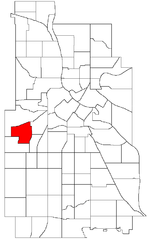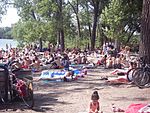Calhoun Isles, Minneapolis

Calhoun-Isles is one of the official communities (a grouping of several official neighborhoods) in the U.S. city of Minneapolis. It contains the Uptown business district and the name "Uptown" is frequently (though somewhat incorrectly) used to refer to the entire community. The name of the community refers to its most prominent physical features, the large and publicly accessible lakes, Bde Maka Ska (previously known as "Lake Calhoun") and Lake of the Isles. Calhoun-Isles is an affluent part of the city, and people of upper middle class means and above, including young professionals and older millionaires, inhabit the community. The Uptown district is considered by many to be the nighttime playground of the young and trendy of the Twin Cities.
Excerpt from the Wikipedia article Calhoun Isles, Minneapolis (License: CC BY-SA 3.0, Authors, Images).Calhoun Isles, Minneapolis
21st Street West, Minneapolis Bde Maka Ska - Isles
Geographical coordinates (GPS) Address Nearby Places Show on map
Geographical coordinates (GPS)
| Latitude | Longitude |
|---|---|
| N 44.9613 ° | E -93.3097 ° |
Address
21st Street West 2227
55405 Minneapolis, Bde Maka Ska - Isles
Minnesota, United States
Open on Google Maps










